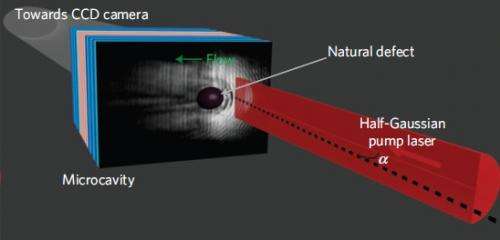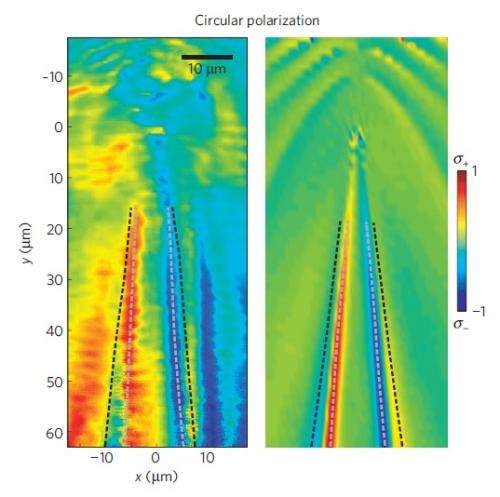September 12, 2012 feature
Point-like defects in a quantum fluid behave like magnetic monopoles

(Phys.org)—No one has ever definitively observed a magnetic monopole, the hypothetical fundamental particle that has only a north or south magnetic pole, but not both like normal magnets do. However, scientists have observed a few types of monopole analogues – objects sometimes described as "quasiparticles" that behave like magnetic monopoles but don't meet all the requirements to be one – such as excitations in spin-ice crystals and in one-dimensional magnetic nanowires. Now in a new study, scientists have observed a new type of monopole analogue in the form of tiny defects that arise in quantum states of matter called Bose-Einstein condensates (BECs). The discovery could help scientists better understand the fundamental nature of magnetism and may also lead to novel devices such as magnetronic circuits.
The scientists, led by Alberto Bramati at the Laboratoire Kastler Brossel of Ecole Normale Supérieure, University Pierre et Marie Curie and CNRS in Paris, France; Guillaume Malpuech from the Institut Pascal at Clermont University, France; and Alberto Amo at the Laboratory for Photonics and Nanostructures at CNRS in Marcoussis, France, have published their study in a recent issue of Nature Physics.
"We have found evidence of quasiparticles that behave like magnetic monopoles," Amo told Phys.org. "While electric charges exist in the form of electrons or protons, magnetic charges have never been observed as elementary particles. In our work we have created 'artificial' particles that behave like them, opening the possibility of experimentally studying their properties."
As the researchers explain, the modern intrigue with monopoles began when physicist Paul Dirac showed in 1931 that the laws of quantum mechanics are consistent with the idea of magnetic monopoles. Specifically, he showed that the existence of magnetic monopoles requires that electric charge is quantized, and one of the core concepts in physics is that the electron charge is indeed very well fixed.
However, just because the laws of quantum mechanics don't forbid the existence of monopoles doesn't mean that the hypothetical particles are easy to find. Some models predict that magnetic monopoles may be too rare and too heavy to observe in particle accelerators (although the Monopole and Exotics Detector At the LHC [MoEDAL] is trying).
In the current study, the researchers based their experimental set-up on recently proposed methods showing the potential for observing monopole analogues in BECs. A BEC, which is a large group of bosonic particles in the same quantum state, has a lot in common with the monopole characteristics theorized by Dirac.

"In 1931, Dirac understood that a magnetic monopole would be a particle with a wavefunction with two main characteristics: a node, that is, a minimum of the density at some point of space, and a particular phase structure around such node," Amo said. "Bose-Einstein condensates are macroscopic quantum states whose wavefunction can be manipulated almost at will. In our work we have engineered the wavefunction of a polariton condensate to have the characteristics that Dirac attributed to monopoles, and we have shown that indeed it behaves like a monopole. The main difference with Dirac's work is that he considered monopoles as real fundamental particles, like electrons are, but they have never been observed. In our work we have created a monopole analogue made out of many, many particles with a collective wavefunction very similar to the one described by Dirac for the monopoles."
In their experiment, the researchers first created a BEC at a very cold temperature of 10 K by confining photons and quasiparticles called excitons in a semiconductor microcavity. When the photons and excitons couple, they form polaritons, and the resulting polariton fluid can be easily manipulated with optical techniques. When the polariton fluid encounters an obstacle, for instance a defect in the microcavity structure, it forms one-dimensional (point-like) solitary waves called solitons. Finally, a magnetic field arising from the dielectric properties of the microcavity splits each soliton into a pair of half-solitons of opposite magnetic charge. These half-solitons interact in opposite ways with the magnetic field, behaving like one-dimensional monopoles.
Still, the researchers explained that these one-dimensional half-solitons of opposite magnetic charge are not true magnetic monopoles.
"A true magnetic monopole would be a fundamental particle like electrons or quarks are, with the characteristic of being a source of a magnetic field (in the same way that an electron is a source of an electric field)," Amo said. "However, they have never been observed despite the ongoing experiments at the LHC. Our monopoles are analogues: they are formed of many, many particles that collectively behave like a monopole; that is, they behave as if they were a source of magnetic field."
The researchers could experimentally confirm that the half-solitons experience opposite magnetic forces by measuring the polarization patterns in the condensate, which revealed that each half-soliton travels a separate trajectory in the magnetic field. The researchers also predict that, depending on their charges, half-solitons engage in either attractive or repulsive interactions with each other, another characteristic of monopole behavior.
Another interesting feature of the half-soliton monopole analogues is that they travel through the quantum fluid at nearly the speed of light, which is explained by the fact that they can be thought of as charged partly photonic quasiparticles.
In the future, half-soliton monopole analogues could find uses in new types of electronics, such as in the development of magnetronic circuits.
"A magnetronic circuit would be a circuit in which, instead of mass or electrical charge, what would be used to transport information would be a magnetic monopole analogue," Amo said. "In such circuits, the magnetic monopole analogues will carry signals from one spin-optronic transistor to the other. As the monopoles are made of partly photonic particles, they can travel at very high speeds and work at very high frequencies (100 GHz and higher).
"Another interesting element is that these circuits would use the spin of the electrons forming the polaritons and the polarization of light to transfer information. There would be no mass transport and this would make them robust against different sources of scattering."
More information: R. Hivet, et al. "Half-solitons in a polariton quantum fluid behave like magnetic monopoles." Nature Physics. DOI: 10.1038/NPHYS2406
Journal information: Nature Physics
Copyright 2012 Phys.org
All rights reserved. This material may not be published, broadcast, rewritten or redistributed in whole or part without the express written permission of PhysOrg.com.



















